Comptroller Kevin Lembo Archive > News
COMPTROLLER LEMBO ISSUES FIRST PROJECTION OF FY 17, SHOWS BUDGET APPROXIMATELY IN BALANCEComptroller Kevin Lembo today issued his first projection of the Fiscal Year 2017 budget, reporting early results are consistent with the budget plan.
While income tax withholdings are initially on pace to meet budget targets, more data is needed to improve the clarity of the fiscal picture as the year continues.
"The biggest source of revenue volatility is in quarterly income tax filings,” said Lembo. “Those workers have earnings closely tied to Wall Street and in turn, their tax payments are subject to the ebb and flow of the stock market. We will have a more complete revenue picture once quarterly payments owed September 1 have been accounted for."
In his letter to Gov. Dannel P. Malloy, Lembo acknowledged the difficulty in achieving projected cost savings, urging continued managerial diligence throughout government to meet the targeted goals.
Lembo also noted that Connecticut continues to recover jobs lost in the Great Recession, but still lags behind the national average.
"We remain on a relatively slow path to recovery,” said Lembo. “The state is adding back jobs, but has yet to achieve the type of wage growth required to jumpstart the economy."
"It is too early to draw conclusions this early in the fiscal year. Increased growth throughout the economy and diligent monitoring of state expenses will be required to maintain a balanced budget moving forward."
Lembo will issue a final unaudited report on Fiscal Year 2016 on September 30, and a final audited report at the end of the calendar year.
Lembo pointed to some of the latest economic indicators from federal and state Departments of Labor and other sources that show:

• The preliminary (prior to accrual and audit) Fiscal Year 2016 increase in the withholding portion of the income tax from the prior year was 4.4%. Through July of Fiscal Year 2017, adjusting for equivalent payroll deposit dates, income tax withholding is running close to last fiscal year’s rate of increase.
• Payroll driven withholding receipts are the largest single source of state tax revenue accounting for over 60% of the total income tax receipts. It should also be noted that the Fiscal Year 2016 receipts incorporated a tax increase. For FY 17, total income tax receipts from withholding, estimated payments, and final payments are expected to grow 3.7% above last fiscal year’s estimated receipts.
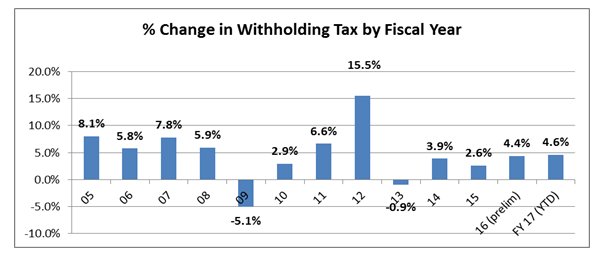
• Preliminary data from the Department of Labor shows that the state gained 1,700 payroll positions in July bring the total level to 1,693,000. On a twelve-month basis the state has added 20,200 jobs. June’s original job gain of 7,900 was revised down to a still very strong gain of 5,800.
• Connecticut has now recovered 98,800 positions, or 83.0% of the 119,100 seasonally adjusted total nonfarm jobs that were lost in the state during the March 2008 - February 2010 employment recession. The state needs to reach the 1,713,300 seasonally adjusted job mark to enter an employment expansion. This will require 20,300 additional nonfarm jobs to be created. Connecticut’s nonfarm jobs recovery is now 77 months old. At the current annual pace of job additions, pre-recession employment levels would be attained within the next twelve months.
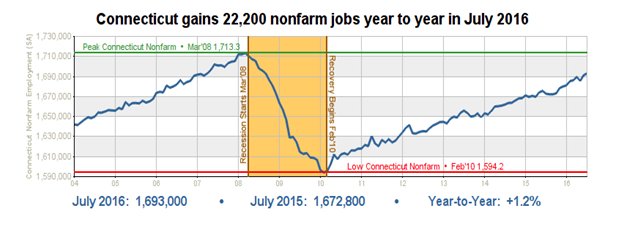
As the state's employment recovery has progressed over the past year, an increasing number of job sectors have posted sustained employment gains.
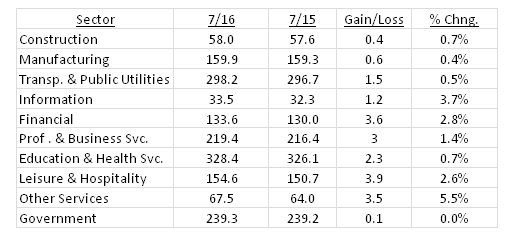
• U.S. employment has been advancing at a rate of 1.7% over the twelve-month period ending in July; Connecticut's employment growth was 1.2% for the same period.
• Connecticut's unemployment rate was 5.7% in July; the national unemployment rate was 4.9%. Connecticut’s unemployment rate has continued to decline from a high of 9.5% in October 2010.
• There were 108,600 unemployed job seekers in Connecticut in June. A low of 36,500 unemployed workers was recorded in October of 2000. The number of unemployed workers hit a recessionary high of 177,200 in December of 2010.
![]()
• Average hourly earnings at $30.15, not seasonally adjusted, were up $1.35, or
4.7%, from the July 2015 hourly earnings estimate ($28.80). The resultant
average Private Sector weekly pay amounted to $1,013.04, up $51.12, or 5.3%
higher than a year ago.
• For the last several months, the Department of Labor has noted that this strong rate of pay increase in Connecticut is inconsistent with several other data sources. Supporting this conclusion is the fact that comparable data for the nation shows hourly earnings advancing at a 2.6% rate and weekly earnings up 2.3%.
• Connecticut ranked 36th nationally in income growth for the 1st quarter of 2016 based on personal income statistics released by the Bureau of Economic Analysis on June 22. The state’s personal income was growing at an annualized 3.1% rate in the 1st quarter of the year. This is the same growth level recorded in 2015.
• Personal income statistics for 2nd quarter personal income growth will be
released on September 28th.

• According to an August 24th release from Connecticut Realtors, single-family
residential home sales decreased 8.2% in July 2016 from the same month a year
earlier. The median sale price fell 2.9% to a price of $265,000. Townhouse and
condominium sales decreased 18.1% from last July; although the median price
increased by 1.8% to $167,500.
• Nationwide total existing-home sales, which are completed transactions that include single-family homes, townhomes, condominiums and co-ops, fell 3.2 % in July from last July. This was the first year-over-year drop since November 2015. Severely restrained inventory and the tightening grip it’s putting on affordability is the primary culprit for the considerable sales slump throughout much of the country last month according to the National Association of Realtors. Despite the sales volume slowdown, the median price rose by 5.3% in July.
• For the first half of 2016, Connecticut home sales are up 18% over last years. Sales were up 17% in 2015. So far in 2016, median home prices in the state are down 1.2%. In 2015 prices dropped 2.2% and in 2014 they were down 3.3%.
• According to Berkshire Hathaway HomeServices 2nd quarter report, inventory
for single family homes in Connecticut was 9.6 months for the 2nd quarter of
2016, up from 8.4 months in the 1st quarter of 2016. Inventory for condominiums
was 8.7 months, up slightly from 8.3 months in 1st quarter of 2016. This number
tells you how many months it would take for all the current homes on the market
to sell, given the monthly sales volume. Four to five months of supply is
average. As the number rises it indicates that there are more sellers than
buyers, or a buyer’s market.
Consumers
• According to an August 12th report from the Commerce Department, U.S. retail sales were unexpectedly flat in July. Sales in July showed little change from June. The June reading was revised upward to 0.8%. Retail sales in June were previously reported to have increased 0.6%.
• Excluding gasoline, retail sales rose 0.2 percent last month. Gas prices are forecast to stay low through the summer, at an average of $2.19 a gallon, according to a report from the U.S. Energy Information Administration.
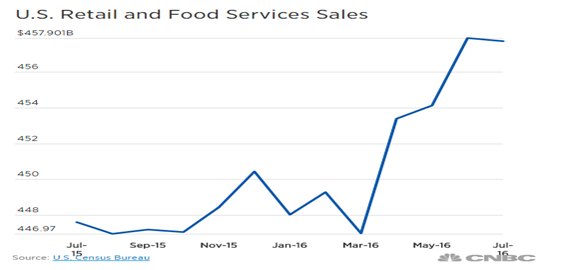
• The University of Michigan reported that its final index of sentiment stood at 89.8 in August compared with 90 in July. The share of households that expected their finances to improve fell to 29%, the smallest percentage since late 2014. The drop was especially large for those younger than 45. While long-term inflation expectations dropped to the lowest on record, consumers anticipated smaller income gains.
• The Federal Reserve's report on consumer borrowing showed consumer credit increased at a seasonally adjusted annual rate of 4.1% in June. Revolving credit increased at an annual rate of 9.7%, while non-revolving credit increased at an annual rate of 2.1%. The graph below shows the percent change in consumer credit since 2008.
% Change in Consumer Credit
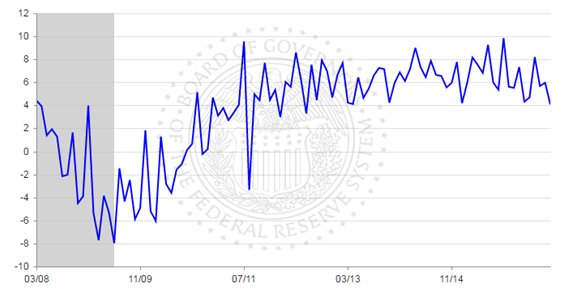
Business and Economic Growth
• According to the August 26th second estimate by the Bureau of Economic Analysis, GDP in the 2nd quarter of 2016 grew at a 1.1% annual rate. In the 1st quarter GDP grew by 0.8%.
• The advance in real GDP in the second quarter primarily reflected gains in
consumption spending, a smaller decrease in nonresidential fixed investment, an
upturn in exports, and a smaller decrease in federal government spending. These
were partly offset by a larger decrease in private inventory investment and
downturns in state and local government spending, in residential fixed
investment, and in imports.
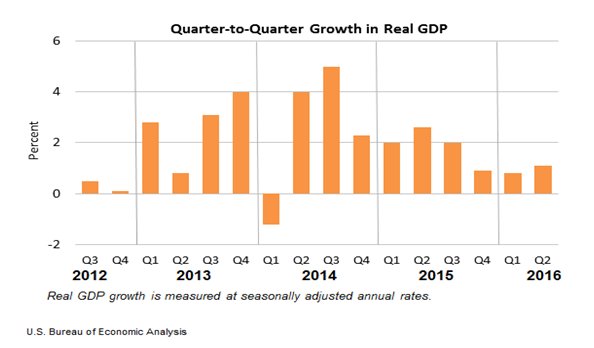
• Before-tax corporate earnings fell 4.9% in the second quarter from a year earlier, the fifth consecutive decline and the worst streak since the end of the recession in mid-2009. The profit slump softens the outlook for already-weak business investment and also poses a risk to continued strength in hiring.
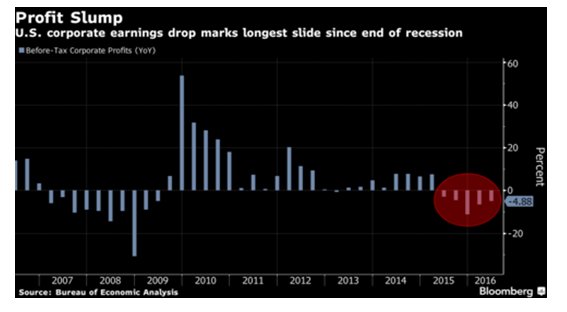
• The Commerce Department’s August 25th report on durable goods orders (items ranging from toasters to aircraft meant to last three years or more) rose a seasonally adjusted 4.4% in July from the prior month. This was the largest monthly jump since October.
• Much of the gain was due to civilian aircraft orders, but orders for core capital goods that businesses had been reducing posted their largest gain since January.
• A closely watched proxy for business investment, new orders for nondefense capital goods excluding aircraft, rose for the second-straight month, up 1.6% from June.
• Rising core capital outlays by businesses is seen as key to boosting worker productivity and wages, as well as increasing corporate profits. Productivity, or output per hour worked, fell in the second quarter for the third consecutive period, the longest streak of falling productivity since 1979.
• The service sector, which is the largest sector of the economy, remained weak in August according to Markit Economics. The flash services purchasing managers’ index (PMI) for August came in at 50.9, to remain just above the threshold of 50. Anything below 50 indicates a contraction in the sector.
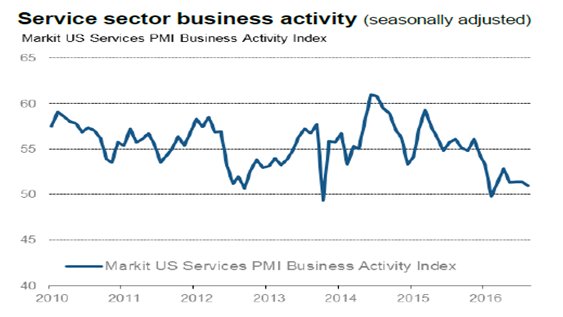
• Despite the lackluster reading in August, looking ahead, service providers
are upbeat overall about their prospects for growth during the next 12 months.
The degree of confidence changed little since the previous month and remained
well above the survey-record low seen in June. Anecdotal evidence cited
sustained optimism regarding the economic outlook, alongside hopes of a
post-election rebound in client spending.
• The Wall Street Journal’s survey of 60 economists indicates a small probability of a recession within the next 12 months. The probability has moved down slightly in August from 22% to 21%.
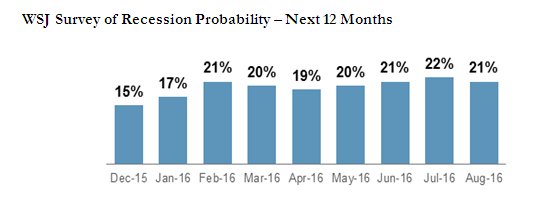
• The State Labor Department’s scorecard for business activity has been generally positive with some slippage over the three-month period ending in July.
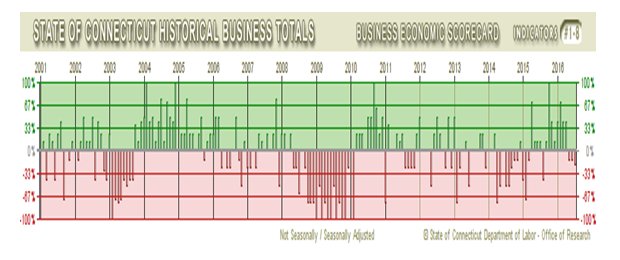
Stock Market
• Estimated and final income tax payments account for approximately 40% of total state income tax receipts. Both the estimated and final payments had a negative rate of growth in Fiscal Year 2016.
• The first large estimated payments for Fiscal Year 2017 will be made in September. That will provide a sense of emerging trends in the new fiscal year.
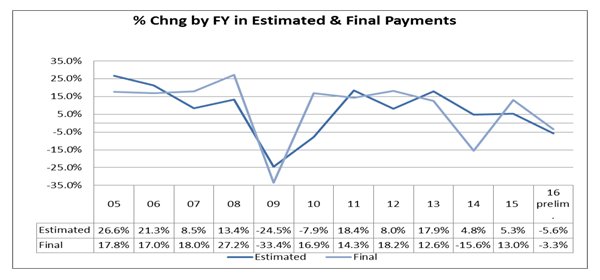
The graphs below show the year-to-date movement in the DOW and the S&P
respectively at this writing. There has been significant market volatility
following the Brexit vote.
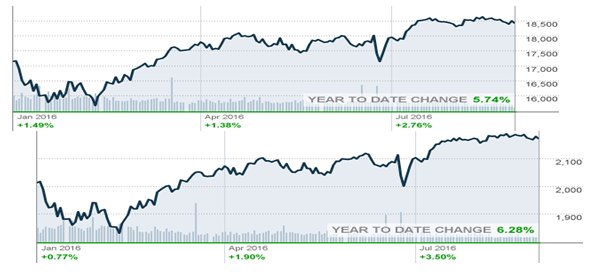
***END***
